Interview
Scenes of Horror — “Poltergeist,” “The Exorcist,” and “The Amityville Horror”
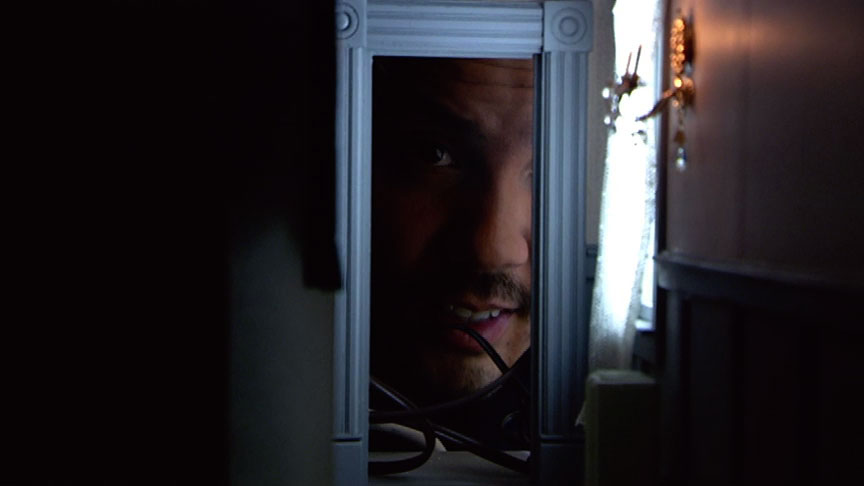
Paul Pfeiffer installing Dutch Interior (2001) at MIT List Visual Art Center, Cambridge, MA, 2003. Production still from the Art in the Twenty-First Century Season 2 episode, Time. © Art21, Inc. 2003.
Paul Pfeiffer discusses his diorama-inspired sculptures that play off of popular horror movies.
ART21: Can you talk about Poltergeist? It’s one of the few sculptural pieces you’ve produced.
PFEIFFER: Well, one thing about Poltergeist is that, although it seems most obviously sculptural, in terms of the production process, it is also digital and in a sense also filmic. The title refers to the movie Poltergeist, and the sculpture specifically is a detail in a scene from the movie, but an important detail, I think. The detail it relates to is a moment in the kitchen in this haunted house in the suburbs in California somewhere. Everything seems normal, and then, one day in the kitchen, Mom turns around and finds all the kitchen furniture rearranged, in literally the blink of an eye, into this baroque configuration. There’s this elaborate pile on the kitchen table. I think of that moment as being similar to the stairway in The Amityville Horror, in that it describes a kind of an exchange or a communication that is happening between a human entity and something that would be its reverse or its antithesis—something not human.
I studied this scene for a while and figured out a way to reproduce that figure piece-by-piece, or that configuration piece-by-piece, in a 3-D rendering program on the computer. I sent the file containing the coordinates of this three-dimensional model to a company in Los Angeles that turned it back into an object. And the way they did that is using a rapid prototyping machine that is normally used to make things like sunglasses and automobile parts—to get from the invention step to the step where you can then mass-produce the object. But what’s really happening with this machine is a block of dust is collected in a glass box, and then lasers come down and, following the coordinates in the computer file, selectively meet. And where they meet, it generates just enough heat to fuse the plastic particles into a solid form. And it goes this way, working from the bottom upwards, in minute layers. It’s a bit like a laser print, but thousands of laser prints, one on top of another, to produce a three-dimensional form. At the end, the glass box is lifted off and the excess plastic powder is blown away to reveal this object.
So, one of the interesting things about it is that, if you look at it on a micro-level, because of the way it’s made, it’s almost the way a tree grows from the inside out. What you have left is a very fine pattern that’s almost like tree rings. If you inspect it closely enough, you can kind of tell how this thing was made, but otherwise it seems very difficult to me to have any sense of how it was made. That was what interested me about the process: aside from the manual clicking-and-dragging of creating the computer model from the original source material of the movie screen to the finished object, it wasn’t touched by human hands. And in the end, this object arrived at the museum, packed in Styrofoam bubbles, as though by magic. An object made by machines, but—in the way I look at it—made by a kind of ghost in the machine.
ART21: What do you think this speaks to, for other people?
PFEIFFER: I’m not sure. But the thing that really interested me in the process is that we’re talking about a technology that is very much in use in the world and is really the way that objects that are much more familiar to us in everyday use—this is the way they’re made. They’re prototyped with a machine like this. So for me, it’s a bit like using the vernacular of our time. I’m attracted to the idea of working in a way that is not of the nineteenth century but is really of today. I don’t know if any of this comes across in the object as such. And in some ways, I feel like maybe it’s one of the most challenging things that I’ve done. It provides the least, in terms of a point of entry. But for me, the point of entry in that piece has to do with the question of how it was made.
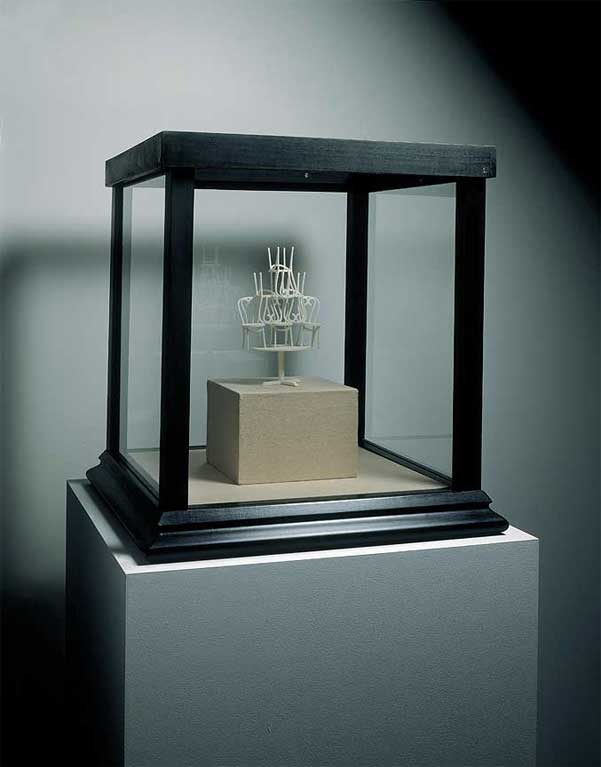
Paul Pfeiffer. Poltergeist, 2000. Laser-fused polyamide powder, and wood, glass, and linen vitrine; Object: 4 × 4 × 8 inches, Vitrine: 22 × 22 × 24 inches. Edition of 3, AP of 2. Photo by Sheldon Collins. Courtesy of the artist and Paula Cooper Gallery, New York.
ART21: Do you feel that you are utilizing technology to suit your interests as an artist, or that the technology is pulling you along, making you as an individual in the process of working with it?
PFEIFFER: I guess that’s the contradiction I feel working as an artist today. These days, we live in a world of incredible image-making tools. And in a way, it’s not even the tools themselves. It’s that you are really dealing with a system. There’s a huge machine, or a huge infrastructure that undergirds every individual image we see on TV. And for me, it’s very hard to dissociate the single image from that entire network. So, the question always comes up: Who is using whom, or who makes whom? Is the image making us, or do we make images? It seems really difficult to tell these days. It’s a double-edged sword.
It’s reminds me of a definition of what vernacular is, that I read once: it’s that thing which both institutes and subverts the rule. So, can you get beyond the spectacle by making more spectacle? It’s an interesting question to me. In a way, you can’t attempt to push the envelope without in some way being involved or inside the envelope. At the same time, I’m not so attached to a model of political transgression that is so centered on the individual. I think things can be done creatively and in terms of advancing a greater liberation of oneself and other people, without there having to be a leader of the revolution or even a dramatic spectacle of revolution per se.
ART21: Your piece Dutch Interior—let’s talk about that. Where did the desire to make that come from?
PFEIFFER: One of the things that has always interested me is the miniature dollhouse. Some of the very earliest personal projects that I undertook when I was a teenager were making, not really dollhouses, but miniature interior settings. What I used to do is make these settings, and at the time, I didn’t really have access to dollhouse furniture or stores and that kind of thing. So, it was really just working from scratch. And I made a 1920s-looking American grocery store or five-and-ten stores, and I remember making an antique shop and various other things, which my mom was really proud of me for. But then was horrified because, at some point, I would take them outside to the backyard and douse them with kerosene and then burn them. I don’t know why, but there was something, somehow, fascinating about watching this miniature world go up in flames. I didn’t have a video camera at the time.

Paul Pfeiffer installing Dutch Interior (2001) at MIT List Visual Art Center, Cambridge, MA, 2003. Production still from the Art in the Twenty-First Century Season 2 episode, Time. © Art21, Inc. 2003.
ART21: But do you think it was about a filmic impulse?
PFEIFFER: Perhaps it was something like a filmic impulse. I guess what I was creating was something like the fireplace—that I could look into and watch this strange morphing of material that was going on as it burned. No living things involved—it was just really about wanting to make a certain kind of moving image. I also find it interesting that, years later, somebody told me that some of the first works that Robert Gober did—that I don’t think are very well known—are dollhouses that he would then burn.
ART21: Was there any theme in the settings?
PFEIFFER: Well, the one thing that I had at the time was a book on how to make dollhouses. And it so happened that, within this book, what you are given is a series of kind of quintessential American interior genres: the five-and-ten-cent store and the antique store, various kinds of domestic interiors and different periods or different interior decoration styles. So, in a way, that was my inspiration—not so much the particular environment I was living in, because I was actually in a small town in the Philippines at that time, but more these archetypal interior spaces that I was looking at in a book.
ART21: Do you think there’s a relationship to religious altars in there?
PFEIFFER: I suppose there is, yes. I actually did make some miniature religious themes as well. I made several versions of a miniature nativity scene. But I also think what we are talking about is: I grew up in a university setting that was Protestant. And that also means that it was American; it was basically built by American missionaries. And, more generally speaking, in the Philippines today, it is hard to walk down the street without consuming the detritus of American pop culture. So, it sort of made sense that, living in the tropics, I was still influenced by a book representing images of American suburbia. In a way, that was part of the mindset.
ART21: So, you weren’t thinking of a world that was real.
PFEIFFER: Yes. One of the most compelling images at the time for me was the movie The Exorcist because I was a teenager when that movie came out and never saw it and was not allowed to see it. But at some point, it was almost all-consuming, in terms of the kind of terror that it inspired. One of the very first diorama pieces that I have made as an adult was essentially returning to that moment. It occurred to me that the bedroom of Reagan in the movie, The Exorcist, is probably the architectural setting that I grew up with as the image of terror, and it’s something that I never even saw. It was something that I just recreated in my head. So, I literally watched the movie over and over again, memorizing the details of that room, until I could physically fabricate that room in miniature. I gave it the title Quad Nomen Mihi Est?, which is a reference from the movie as well: it’s the priest talking to the possessed girl and asking, in Latin, “Who are you?”
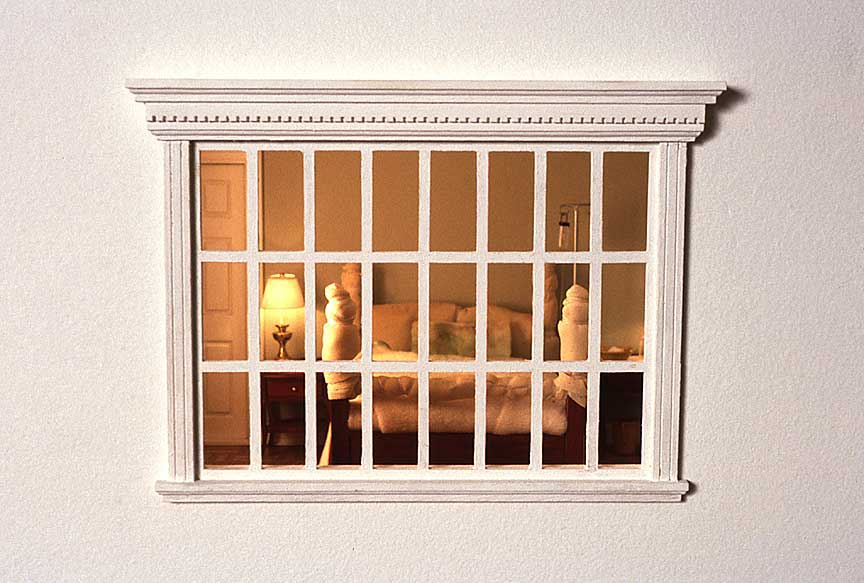
Paul Pfeiffer. Quod Nomen Mihi Est?, 1998. Wall-recessed diorama; 10 × 16 × 18 inches. Collection of Lois Plehn. Courtesy of the artist and Paula Cooper Gallery, New York.
ART21: And so, all this led up to the work Dutch Interior?
PFEIFFER: All right, well, to begin with—I think for a long time, I’ve had this fascination with domestic interiors, and it goes back to my dollhouse-making days. And I suppose I’ve had a special interest in domestic interiors that also are scenes of horror or of the uncanny. And maybe what I am really interested in is what I think of as the uncanny—that moment when the familiar turns against itself and suddenly reveals itself to be, in fact, quite strange. So, with the piece Dutch Interior—where that came from was another movie that features scary domestic interiors, that goes back to my early childhood imagination, and it’s the movie, The Amityville Horror.
Revisiting that movie, I think what is really interesting (because ultimately it’s kind of a bad movie) is how the camera becomes a stand in for the devil—so that the movie is really filmed with these very discomforting scenes, where you are viewing the family. And you’re viewing this otherwise ideal suburban house from behind a bush, or peeking around a tree, or peeking in through a window, or through some corner in the house that really wouldn’t be the place where a human being would stand. It’s either too low or too high, or from someplace that would really be uninhabitable to an adult human—maybe a child, but maybe not even that. I started watching it out of a curiosity about how the camera was really being used. And what I noticed is that, in that movie, the stairway plays a very important role. In a way, it’s the central corridor, along which a meeting of gazes occurs between the human inhabitants (the family) and this non-human inhabitant, the devil.
There are many really disturbing scenes, where you’re looking down the staircase at the family coming up, or looking up the staircase at the priest coming down—that kind of thing. And that’s what led me to the idea of recreating this scenario, of the central stairway in the house. I worked with a person who makes miniature settings for Hollywood movies in Los Angeles. And he helped me create this interior.
So, in the final piece, what you have is a moving image that’s built around this dollhouse-size diorama. You really have two images, and the viewer comes to be in the middle of a circuit loop, or a video-feed loop between these two images. One image is a large projection of a view looking from the top of the stairs down into the entryway of the house, and it’s coming through a live feed from inside the diorama, using a little surveillance camera. And it’s projected on a wall that’s roughly thirteen feet high and eighteen feet wide. And as you move close to the wall, the image sort of disintegrates into the screen pattern of the projector, and you find a little hole with light coming out of it. And looking through the hole, you see the diorama itself, which is built into the wall. And you find yourself looking through the peephole and looking in the opposite direction from the bottom of the stairs and the entryway of the house, upwards towards the second floor where the camera is—although it’s hidden, so you don’t see the camera. And that’s it.
It’s a circuit between these two images: the actual dollhouse that you can only see through the peephole, and then this other view, which is a video image offered by the surveillance camera and projected bigger. As a viewer, you’re sort of circulating between the two.
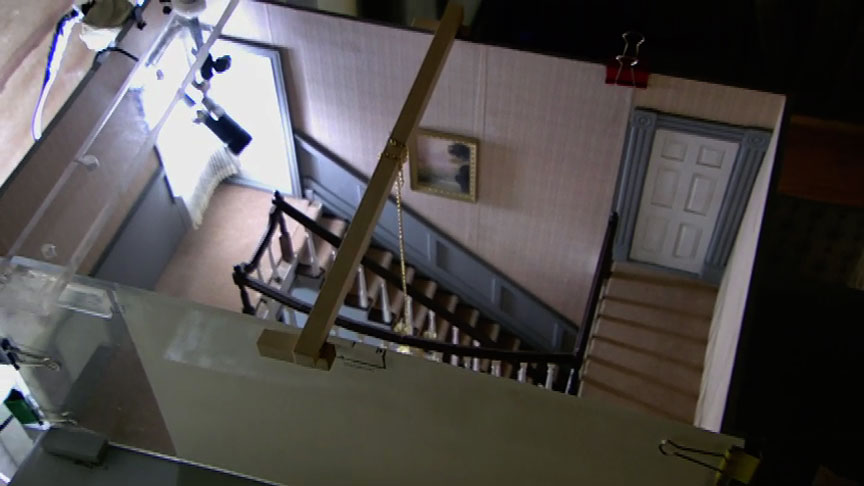
Paul Pfeiffer installing Dutch Interior (2001) at MIT List Visual Art Center, Cambridge, MA, 2003. Production still from the Art in the Twenty-First Century Season 2 episode, Time. © Art21, Inc. 2003.
ART21: So, you took this image from your childhood and you heightened it?
PFEIFFER: The Amityville Horror I also never saw as a kid, but I got a hold of a copy of the paperback book and read through that completely, and it terrified and fascinated me. Helter Skelter was another one—same thing. And I suppose, looking at it now, the interest is not so much the occult per se. It’s really a question about the narrative or the image that can inspire that kind of terror.
And what is terror anyway? I think of terror as, really, a disturbance in one’s sense of the normal, or disturbance in one’s sense of [being] grounded—who I am, and who other people are, and what the world is, and maybe what the boundary between these things are. In the case of The Exorcist, it literally is about a force that mixes up the boundary of the individual and the world outside the individual. I’m really interested in that discomfort and that sense of alienation from one’s sense of centeredness, in one’s body or in one’s sense. And so, with the Amityville Horror piece, I suppose what really interested me about the stairway was that here was an architectural rendering of just that: an image or a space that represented a dialogue between the “I” and the “not-I” and the kind of terror and the sense of the home becoming an un-home that that represents.
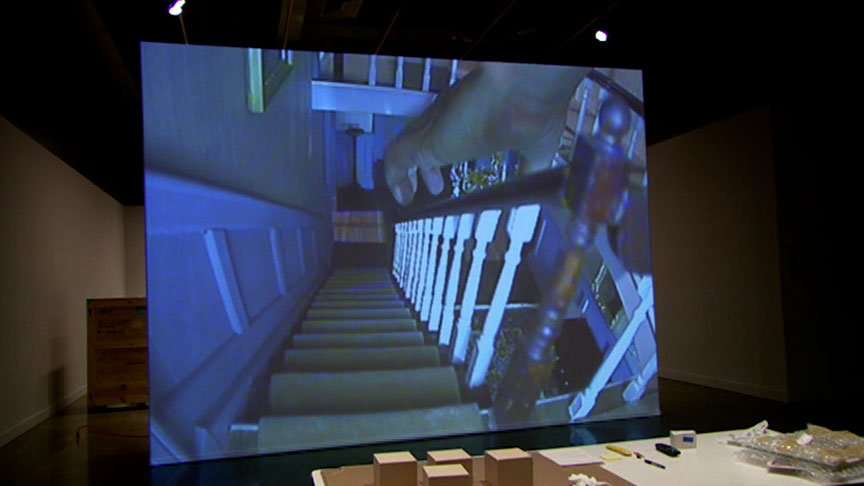
Paul Pfeiffer installing Dutch Interior (2001) at MIT List Visual Art Center, Cambridge, MA, 2003. Production still from the Art in the Twenty-First Century Season 2 episode, Time. © Art21, Inc. 2003.
ART21: Is it an interest in the heightened sense or spectacle, like in sports?
PFEIFFER: Yes, the same thing in the sports spectacle. My interest, in a way, is: how does an individual function and even excel in a situation of that kind of extreme visual and emotional overload? I came across something that doesn’t relate directly, but I find really interesting, and that’s an account from the writer Frantz Fanon. He describes the child of the colonies moving to the big city—say, from the Caribbean to Paris. And in a particular paragraph in the book, he narrates that the child of the colonies comes to Paris and finds himself on a subway, and he’s smoking a cigarette. And as he smokes, he sees himself smoking. And everything that he does, he sees himself doing it, almost as though he were looking at himself from somebody else’s viewpoint—no longer centered in his body but somewhere out there.
And that’s a curious thing. It makes me think of what an actor might feel like before the camera. In a sense, everything that the actor is doing is being done for an invisible audience that doesn’t exist yet. Or the actor is doing it for the camera, but really for some imagined sense of a viewer who is going to come later. So, it’s an interesting kind of synchronicity between this specifically colonial setting and a much more common setting today, involving not the colonies but technology and the thinking behind reality TV, for example. It seems like reality itself is being formatted and tailored for precisely this situation, where whatever I do, I’m encouraged to think of myself as potentially being on TV or potentially being before an audience. And I think of that as becoming the definition of reality or the parameters for a kind of reality that we will live in, if we’re not already living in it now.
And there’s a history that comes before that, that relates to the colonies and to, say, even racism. And other things as well—say, schizophrenia, where you have an individual who, for some reason, feels compelled to push past the boundaries of themselves and almost live as though they were somewhere out there, looking back at themselves. This kind of relationship, between the building blocks of subjectivity—or how I define who I am in relation to other people and to the world—and image-making tools is, maybe, the real meat of the exploration that I’m involved in.



